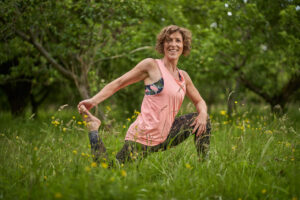Last time we talked about how yoga can help manage stress & improve our mental functioning & wellbeing. We also talked about the delicate balance of the autonomic nervous system. Let’s take this a little further.
Relaxation occurs when our body & our mind is in a state of balance. Yoga helps create space in both our body & our mind which encourages balance & relaxation, creating inner peace, contentment, happiness & self awareness. It helps to reduce blood pressure & heart rate, increase oxygen utilization, improve digestion, the immune system, hormone balance & better neuro-muscular coordination.
If you practice yoga, you will know this just from stepping onto your yoga mat: a sense of peace & calm begins before you even start practicing as your body & mind are aware of what is to come. The physical poses (asanas) in yoga all have different benefits, stimulating different systems in the body: standing poses strengthen leg muscles, open the hips, flex the back & improve circulation; forward bends are calming & restorative; backbends increase flexibility & mobility in the spine, stimulate the central nervous system & may help deal with negative emotions (possibly because we are opening the heart chakra – research into the chakras is still in its infancy so I’ll leave it there for now).
Do you remember at the beginning of the piece last time I was challenged about my claims regarding inversions? Let’s explore the claims behind the benefits of inversions. Dr. Fishman (remember him from part 1?) notes that inversions improve bone density which he attributes to the muscles working against gravity. Reversing the effects of gravity on the body has a profound physiological effect on the body. In 2000 NASA reported that when humans enter zero gravity it causes severe biomedical problems: the sense of balance is destroyed, blood floods upwards speeding up the heart, muscles waste & bone mass drops.
On earth, gravity weighs us down & as the years progress so does the damage: varicose veins & hemorrhoids, the heart falters & more. The ancient yogis called gravity ‘the silent enemy’. So by inverting ourselves, we reverse the effects of gravity. Our body is made up of 60% water, when we upend ourselves, the tissue fluids of our lower body drain more effectively helping to clear congestion.
David Coulter who taught anatomy at the University of Minnesota said, “If you can remain in an inverted posture for just 3-5 minutes, the blood will not only drain quickly to the heart, but tissue fluids will flow more efficiently into the veins & lymph channels of the lower extremities & of the abdominal & pelvic organs, facilitating a healthier exchange of nutrients & wastes between cells & capillaries” Couldn’t have said it better myself.
There are 4 major systems in the body: cardiovascular, lymphatic, nervous & endocrine. Inversions give the heart a break but also challenge it in the opposite way to how it usually works. This means we are benefiting the circulatory system but in a very gentle but very effective way.
We used to think that inversions flooded the brain with freshly oxygenated blood but we now understand that the brain is protected from an influx of blood which would overwhelm its delicate structures. However, we now believe that inversions could affect the movement & production of cerebrospinal fluid which is the juice of the nervous system. The lymph system, like the heart relies on muscular movement & gravity to facilitate its performance. When you are upside down the lymph system is stimulated which strengthens your immune system & starts to drain more effectively.
The effect of inversions on the endocrine system is the least well documented or understood. Some believe that the shoulder stand helps regulate the thyroid gland but it has not been proven; whilst the benefits to the pineal & pituitary glands from headstands have also not been confirmed…yet. At the end of the day, a lot can be gained from being upside down, simply because by having a different physical view of the world can change our mental & emotional viewpoint too.
I think the important thing with inversions, whether you believe in their physiological effects or not, is not to rush into them. Take your time & only work with a good teacher who can guide you safely into & out of the poses. There are plenty of other ways you can practice inversions: legs up the wall (viparita karini) is deeply restorative & doesn’t tax the spine or the neck. Same with bridge pose (setu bada), downward dog, standing forward fold.
So there you have it, the science (in very lay-man’s terms!) behind the enormous positive effects practicing yoga can have on your body, brain, nervous system & immune system. Whilst we may not have ‘proved’ that yoga slows the aging process, if you stack up all the positive impact it does have it certainly suggests it could very well do so.
If you would like to put some of these scientific benefits to the test & practice yoga with Alex her YouTube channel offers free short classes for everyone & is available here: https://www.youtube.com/channel/UCQlKZJ7MeyYc6lqkv6seISw
Alternatively all of her classes are streamed on live on Zoom, for more information message her at alex@alexbannard.com Free resources are also available on her Facebook page: https://www.facebook.com/AlexBannardYogaMindfulness And her website is www.alexbannard.com
Alex is based on the edge of the stunning Cotswolds & has been sharing her love for all things yoga & mindfulness for almost a decade, not just in the UK but also around the world. Her mission is to help everyone discover a more mindful way of living & to encourage them to embrace regular self-care practices for a happier & healthier way of being.
Check out this Uplift video for more information: https://uplift.tv/2017/watch-science-behind-yoga/
Or these articles for more science based facts: https://www.yogajournal.com/practice/everybody-upside-down https://www.gaiam.com/blogs/discover/the-science-behind-yoga https://www.healthline.com/nutrition/13-benefits-of-yoga#section13


